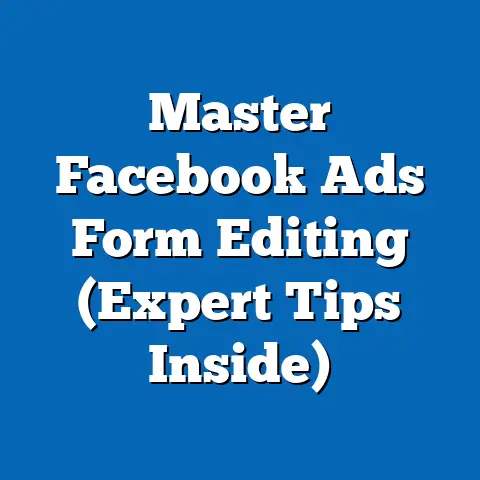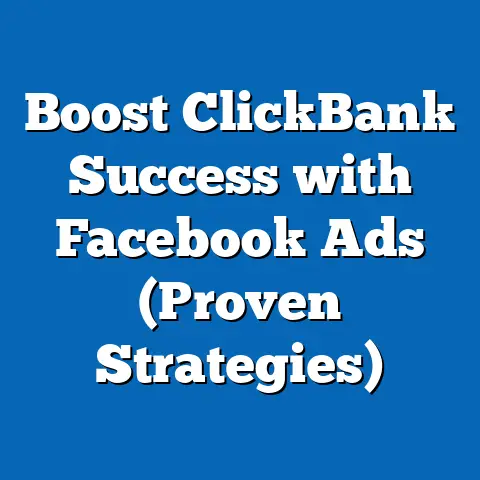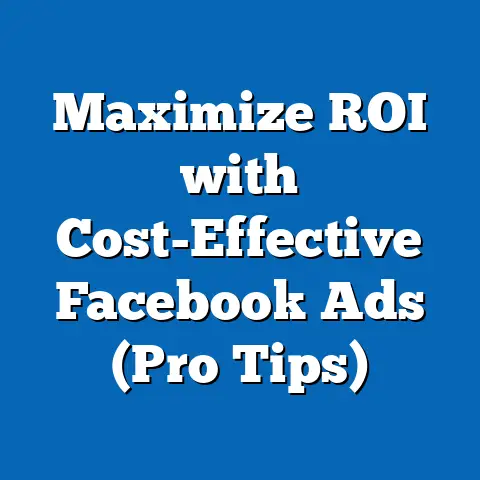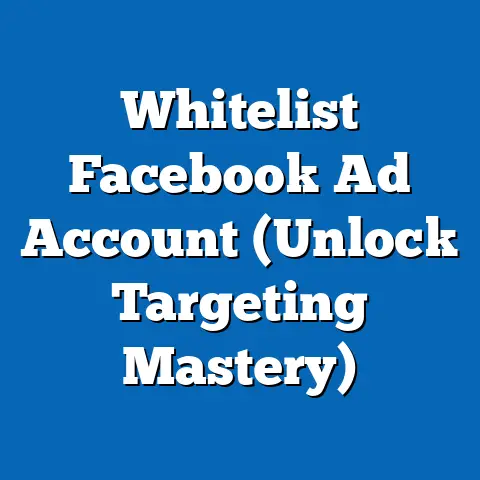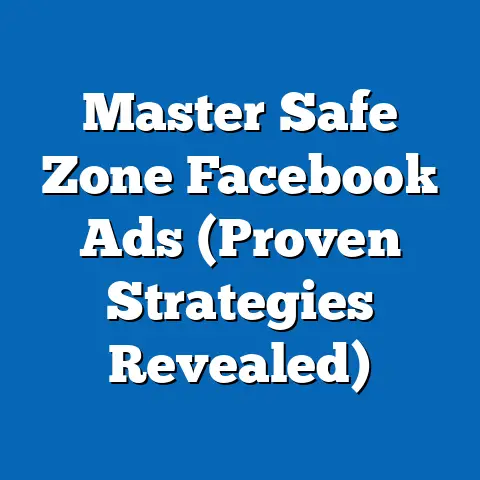Transform Facebook Image Ads with Proven Strategies (Expert Tips)
Do you ever feel like you’re constantly battling against the world around you? For some of us, that battle is with allergies. I know firsthand how allergies can dictate your life, from the food you eat to the places you visit. One minute you’re enjoying a beautiful spring day, the next you’re reaching for a tissue box. That’s why understanding your allergies is so important – it allows you to make informed choices and find solutions that work for you.
In the world of Facebook advertising, understanding your audience is just as crucial. You’re not just throwing information out into the void; you’re trying to connect with real people who have specific needs, desires, and… well, pain points! Just like an allergy sufferer seeks relief, your potential customers are looking for solutions to their problems.
That’s where the power of a well-crafted Facebook image ad comes in. It’s not just about pretty pictures; it’s about understanding your audience, speaking their language, and offering them the relief they’re searching for. In this guide, I’ll walk you through the proven strategies I’ve used to transform ordinary Facebook image ads into attention-grabbing, engagement-driving powerhouses. Let’s dive in!
The Power of Visuals in Advertising
Think about scrolling through your Facebook feed. What catches your eye? It’s likely the images and videos, right? Visuals are the gatekeepers of attention in the fast-paced digital world, and on Facebook, they reign supreme.
Images have the unique ability to evoke emotions and drive action in a way that text alone simply can’t. A compelling image can tell a story, create a feeling, or pique curiosity within seconds. This makes them incredibly powerful tools for advertisers.
Consider these statistics:
- Posts with images see 2.3X more engagement than those without. (Source: BuzzSumo)
- Facebook users are 75% more likely to interact with a post if it has an image. (Source: HubSpot)
These numbers speak for themselves! But it’s not just about slapping any old image onto your ad. It’s about selecting high-quality imagery that is relevant to your target audience and the message you’re trying to convey.
Think back to the allergy analogy. A generic picture of flowers blooming might not resonate with an allergy sufferer. But an image of someone enjoying a clear, sunny day after taking allergy medication? That’s a different story. That image speaks directly to their desire for relief and freedom.
The same principle applies to your Facebook image ads. You need to choose visuals that resonate with your target audience on a personal level and connect with their needs and aspirations.
Key Takeaway: Visuals are crucial for capturing attention and driving engagement on Facebook. Choose high-quality images that are relevant to your target audience and the message you want to communicate.
Understanding Your Audience
Imagine trying to sell sunscreen to someone living in Antarctica. Sounds absurd, right? But that’s essentially what you’re doing if you’re not understanding your audience before creating your Facebook image ads.
Audience research is the foundation of any successful advertising campaign. You need to know who you’re trying to reach, what their interests are, what their pain points are, and what motivates them.
Facebook offers a powerful tool called Audience Insights that can help you gather this crucial data. With Audience Insights, you can gain insights into:
- Demographics: Age, gender, location, education level, relationship status, etc.
- Interests: Hobbies, passions, pages they like, etc.
- Behaviors: Purchase history, online activity, device usage, etc.
By analyzing this data, you can start to build audience personas that represent your ideal customers. These personas should include details like:
- Name: Give your persona a name to make them feel more real.
- Age: What is their age range?
- Occupation: What do they do for a living?
- Location: Where do they live?
- Goals: What are they trying to achieve?
- Challenges: What are their biggest pain points?
- Motivations: What drives them to take action?
For example, let’s say you’re selling a new type of air purifier. You might create a persona like this:
- Name: Sarah
- Age: 35
- Occupation: Teacher
- Location: Los Angeles, CA
- Goals: To create a healthy and comfortable home environment for her family.
- Challenges: Suffering from seasonal allergies, concerned about air pollution in her city.
- Motivations: Protect her family’s health, improve their quality of life.
Now, when you’re creating your Facebook image ads, you can keep Sarah in mind. You can choose images and write copy that speaks directly to her concerns about allergies and air pollution, and highlight the benefits of your air purifier in creating a healthier home environment.
Just like allergy sufferers often seek specific solutions based on their individual allergies, your audience is looking for products and services that address their unique needs. Tailoring your messaging in your ad visuals is key to capturing their attention and driving conversions.
Key Takeaway: Audience research is essential for creating effective Facebook image ads. Use Facebook Audience Insights to gather data and create audience personas that represent your ideal customers. Tailor your messaging and visuals to resonate with their specific needs and pain points.
Crafting Compelling Visuals
Now that you understand your audience, it’s time to craft some compelling visuals! This is where the magic happens. Your image is the first thing people will see, so it needs to be attention-grabbing and relevant.
Here are some key elements to consider:
- Color Schemes: Colors evoke emotions and can significantly impact how people perceive your brand. Choose colors that align with your brand identity and the message you’re trying to convey. For example, blue often represents trust and reliability, while green can symbolize health and nature.
- Composition: The way you arrange elements within your image can influence how people view it. Use the rule of thirds, leading lines, and negative space to create visually appealing compositions.
- Subject Matter: What you choose to feature in your image is crucial. Do you use lifestyle images that show people using your product in real-life situations? Or do you opt for product images that showcase the features and benefits of your product?
Here’s a breakdown of when to use each type:
- Lifestyle Images: Best for creating an emotional connection and showing how your product fits into people’s lives. Use these when you want to tell a story and create a feeling of aspiration.
- Product Images: Best for highlighting specific features and benefits of your product. Use these when you want to focus on the practical aspects of your product and showcase its value proposition.
Branding is also key! Your visuals should be consistent with your brand identity, including your logo, colors, and fonts. This helps build brand recognition and reinforces your brand message.
Let’s look at some examples of successful Facebook image ads that utilize these strategies effectively:
- Example 1: Nike – Nike often uses lifestyle images featuring athletes pushing their limits. These images evoke feelings of inspiration, motivation, and empowerment, aligning perfectly with their brand message.
- Example 2: Casper – Casper uses product images that highlight the comfort and support of their mattresses. They also use clever copy and visuals to address common pain points like back pain and sleeplessness.
- Example 3: Airbnb – Airbnb uses stunning images of unique and desirable properties. These images create a sense of wanderlust and inspire people to book their next adventure.
Key Takeaway: Craft compelling visuals that are attention-grabbing, relevant, and consistent with your brand identity. Consider the impact of color schemes, composition, and subject matter. Use lifestyle images to create an emotional connection and product images to highlight specific features and benefits.
A/B Testing Your Image Ads
Creating a great image is just the first step. You need to test and optimize your ads to ensure they’re performing at their best. That’s where A/B testing comes in.
A/B testing (also known as split testing) is the process of comparing two versions of an ad to see which one performs better. In the context of Facebook image ads, you can test different images, text overlays, calls to action, and other variables to see what resonates most with your audience.
Here’s a step-by-step guide on how to set up A/B tests for your images:
- Create two versions of your ad: Change only one variable at a time. For example, you might test two different images with the same text and call to action.
- Set up your A/B test in Facebook Ads Manager: Facebook makes it easy to create A/B tests directly within the Ads Manager. Simply select the “Create A/B Test” option when setting up your campaign.
- Define your testing parameters: Choose your target audience, budget, and duration for the test.
- Run your test: Let your test run for a sufficient amount of time to gather statistically significant data. Facebook will automatically split your audience and show each version of the ad to a different segment.
- Analyze your results: Once your test is complete, analyze the results to see which version performed better. Look at metrics like click-through rate (CTR), conversion rate, and cost per acquisition (CPA).
- Implement your findings: Use the data from your A/B test to inform your future ad iterations. Implement the winning version and continue testing to further optimize your ads.
Here are some variables you can test in your Facebook image ads:
- Different images: Test different types of images (lifestyle vs. product), different color schemes, different compositions, etc.
- Text overlay: Test different headlines, captions, and text overlays to see what grabs attention and drives clicks.
- Calls to action: Test different calls to action (e.g., “Shop Now,” “Learn More,” “Sign Up”) to see which one generates the most conversions.
Key Takeaway: A/B testing is crucial for optimizing your Facebook image ads. Test different variables to see what resonates most with your audience and make data-driven decisions for future ad iterations.
Staying Compliant with Facebook’s Advertising Policies
Before you launch your perfectly crafted image ad, it’s crucial to ensure it complies with Facebook’s advertising policies. These policies are in place to protect users and ensure a positive advertising experience.
Facebook’s advertising policies cover a wide range of topics, including:
- Misleading or deceptive content: Your ads should be truthful and accurate. Avoid making false claims or exaggerating the benefits of your product or service.
- Offensive content: Your ads should not be offensive, discriminatory, or hateful. Avoid using language or imagery that could be considered harmful or insensitive.
- Prohibited content: Certain types of content are prohibited altogether, including illegal products or services, tobacco products, and weapons.
Compliance is crucial to avoid ad rejection and ensure a positive user experience. If your ad violates Facebook’s policies, it will be rejected and you won’t be able to run it. Repeated violations can even lead to your account being suspended.
Key Takeaway: Familiarize yourself with Facebook’s advertising policies and ensure that your ads comply with all guidelines. This will help you avoid ad rejection and ensure a positive user experience.
Conclusion
Transforming your Facebook image ads is not just about creating pretty pictures; it’s about understanding your audience, crafting compelling visuals, testing and optimizing your ads, and staying compliant with Facebook’s policies. By following the strategies I’ve shared in this guide, you can create Facebook image ads that capture attention, drive engagement, and ultimately, achieve your business goals.
Just as understanding your allergies can lead to better choices and a more comfortable life, understanding your audience and crafting compelling visuals can lead to more effective advertising and a more successful business.
Call to Action
I’d love to hear about your experiences with Facebook image ads! Share your tips, challenges, and successes in the comments below. What strategies have worked best for you? What are some common pitfalls to avoid?
And if you’re looking for more expert tips and strategies on digital marketing and advertising, be sure to subscribe to my newsletter! I’ll share exclusive content, insights, and resources to help you take your marketing to the next level.


